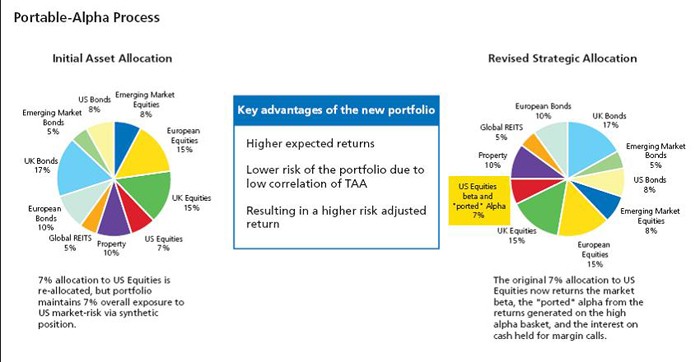Portfolio Rebalancing How to Maintain Proper Asset Allocation
Post on: 27 Июнь, 2016 No Comment

New investors tend to talk about picking individual stocks, bonds, etfs and funds as being the key successful investing. However, as money manager and financial blogger Barry Ritholtz recently pointed out, financial professionals know that asset allocation drives the majority of returns. Making the right decisions about what category (stocks, bonds, commodities, international investments) to put money in will tend to have a far greater impact than picking the “right” fund.
There are frequent articles about optimal asset allocation. The 60 / 40 rule, also known as the golden rule of investing, is to put 60% of one’s funds in stocks and 40% in bonds. This asset allocation tends to provide stock market type returns with much less risk. Another approach to asset allocation is to adjust the mix in part based on one’s retirement date, shifting from more risky to more conservative investments over time Target date funds embrace this philosophy.
However, successful asset allocation requires more than just picking the right mix of stocks, bonds, and other investments. You need to maintain the correct asset allocation over time, or the benefits of proper asset allocation disappear.
If you invest in a target date fund, portfolio allocation and rebalancing over time is handled for you automatically. If you decide to handle portfolio allocation yourself, then the initial weighting is straightforward. As time moves on however and one asset class outperforms another, the portfolio is going to become unbalanced. If stocks do better than bonds then the stock portion of your portfolio will become a larger and larger percentage of the portfolio. If bonds do better then the reverse will be true.
In 2010 Vanguard put together an in depth study called “The Benefits of Portfolio Rebalancing ” which looks at how to:
develop a rebalancing strategy that formally addresses “how often, how far, and how much”: that is, how frequently the portfolio should be monitored; how far an asset allocation can be allowed to deviate from its target before it is rebalanced; and whether periodic rebalancing should restore a portfolio to its target or to a close approximation of the target.
So how do you go about answering the question of “how often, how far, and how much” you should rebalance your portfolio after the initial setup? The vanguard study looks at the three primary methods that can be used for portfolio rebalancing which are:
- The “Time Only” Strategy: As its name implies, investors using this strategy take only timeframe into account when deciding how and when to rebalance their portfolio. Examples of timeframes that could be used for rebalancing are daily, monthly, quarterly or yearly. Once the timeframe chosen is hit, it doesn’t matter if the portfolio has deviated by .5% or 5% from the desired allocation, you rebalance.
- The “Threshold Only” Strategy: Investors using this strategy take into account only a predefined threshold for rebalancing, and time is not considered at all. For example if you were using a 60/40 allocation then you could rebalance using a 1% threshold (meaning for example when the portfolio became 61% stocks and 39%) or a 5% threshold (meaning for example when the portfolio reached 45% bonds and 55% stocks).
- The “Time-and-Threshold” Strategy: This strategy combines the first two approaches meaning that you look at your portfolio for potential rebalancing only at set periods of time, and only rebalance if the portfolio’s weighting is off the desired level by a set threshold. For example you could choose to look at your portfolio on a quarterly basis and only rebalance if the weighting is off by 5% or more at that time.
The report looked at a portfolio with a 60% equity and 40% bond allocation over the last 80 years using each of the above methods. Their analysis concluded that:
A portfolio that was rebalanced more frequently, either because it was monitored more frequently or because it had tighter rebalancing thresholds, tracked the target asset allocation more closely. However, the magnitude of the differences in the average annualized returns and volatility was relatively insignificant.
When you factor trading costs into the equation as well, it becomes clear that rebalancing your portfolio too frequently will end up detracting too much from performance in terms of trading costs to make this a viable option. At the end of the day the report found that:
After taking into consideration reasonable expectations regarding return patterns, average returns, and risk, we concluded that for most broadly diversified stock and bond fund portfolios, annual or semiannual monitoring, with rebalancing at 5% thresholds, produces a reasonable balance between risk control and cost minimization.
So, how do you go about implementing this rebalancing strategy?
Often times if you are investing as part of a 401K plan they give you the option to have your portfolio automatically rebalanced at specific intervals. According to a recent article in the NY Times. with the exception of TD Ameritrade, most online brokers do not offer automatic rebalancing. Many do however offer tools that help you track when and how to execute your rebalancing strategy, but you actually have to place the trades yourself. As trading outside of a non taxable account (IRA, 401-K etc) has tax consequences in addition to additional trading costs, having to take discretion and do the trades yourself manually, is not necessarily a bad thing.
The Psychology of Rebalancing
While rebalancing a portfolio at regular intervals makes logical sense it can be difficult to execute in practice. The reason why is when you go to rebalance your portfolio you will be selling some of the best performing asset class, and buying more of the worst performing asset class. While this seems counterintuitive, this is one of the basic tenets of successful investing.














